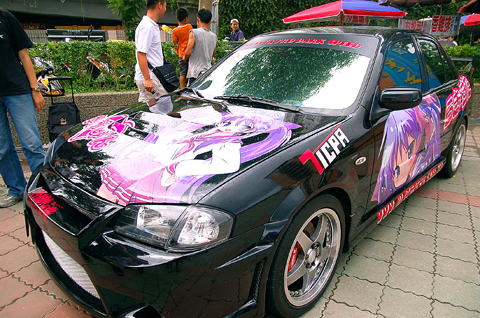If you happen to see cars or scooters on streets bearing images of cartoons, manga or online computer game characters, it’s quite possible that the driver is a fan of itasya (痛車).
Itasya is a Japanese term referring to cars decorated with cartoon or manga images on the outside — a subculture that has been popular in Japan for the past decade.
A fan of Japanese manga and itasya, 28-year-old Liu Chien-liang (劉建良) founded the Taiwan Itasya Culture Promotion Association in February with a few friends.

PHOTO: HSIEH WEN-HUA, TAIPEI TIMES
SEVEN EXAMPLES
At the moment, there are seven itasya in Taipei, Kaohsiung and Tainan, including Liu’s own itasya with “Kokagami,” a character from the manga Lucky Star on the doors, hood and roof.
It took him three attempts before Liu managed to paste Kokagami’s images onto his car.
Liu said that he’s very attracted to Kokagami because she looks cold outside, but is actually just shy on the inside.
WHAT’S IN A NAME?
He said it makes him proud when he drives in the car because it makes him the focus on the road.
The term itasya comes from the Japanese word ita (痛), which means “to hurt” or “painful,” while sya (車) means “car.”
As for why an itasya is called an itasya, Liu said that there are three different explanations.
The first goes that, under Japanese traffic regulations, one has to pay extra fees to put exotic decorations on the outside of a car, and thus it “hurts” to pay the extra money.
The second explanation says that itasya is how the Japanese calls Italian cars, and since they believe Italian cars to be the best decorated ones, the Japanese then chose to call cars decorated with manga characters’ pictures itasya.
The third explanation, Liu said, goes that since the rich decorations on itasya are so colorful, they would “hurt” viewers’ eyes.

SHIPS, TRAINS AND AUTOMOBILES: The ministry has announced changes to varied transportation industries taking effect soon, with a number of effects for passengers Beginning next month, the post office is canceling signature upon delivery and written inquiry services for international registered small packets in accordance with the new policy of the Universal Postal Union, the Ministry of Transportation and Communications said yesterday. The new policy does not apply to packets that are to be delivered to China, the ministry said. Senders of international registered small packets would receive a NT$10 rebate on postage if the packets are sent from Jan. 1 to March 31, it added. The ministry said that three other policies are also scheduled to take effect next month. International cruise ship operators

NUMBERS IMBALANCE: More than 4 million Taiwanese have visited China this year, while only about half a million Chinese have visited here Beijing has yet to respond to Taiwan’s requests for negotiation over matters related to the recovery of cross-strait tourism, the Tourism Administration said yesterday. Taiwan’s tourism authority issued the statement after Chinese-language daily the China Times reported yesterday that the government’s policy of banning group tours to China does not stop Taiwanese from visiting the country. As of October, more than 4.2 million had traveled to China this year, exceeding last year. Beijing estimated the number of Taiwanese tourists in China could reach 4.5 million this year. By contrast, only 500,000 Chinese tourists are expected in Taiwan, the report said. The report

The Forestry and Nature Conservation Agency yesterday launched a gift box to market honey “certified by a Formosan black bear” in appreciation of a beekeeper’s amicable interaction with a honey-thieving bear. Beekeeper Chih Ming-chen (池明鎮) in January inspected his bee farm in Hualien County’s Jhuosi Township (卓溪) and found that more than 20 beehives had been destroyed and many hives were eaten, with bear droppings and paw prints near the destroyed hives, the agency said. Chih returned to the farm to move the remaining beehives away that evening when he encountered a Formosan black bear only 20m away, the agency said. The bear

Chinese embassy staffers attempted to interrupt an award ceremony of an international tea competition in France when the organizer introduced Taiwan and displayed the Republic of China flag, a Taiwanese tea farmer said in an interview published today. Hsieh Chung-lin (謝忠霖), chief executive of Juxin Tea Factory from Taichung's Lishan (梨山) area, on Dec. 2 attended the Teas of the World International Contest held at the Peruvian embassy in Paris. Hsieh was awarded a special prize for his Huagang Snow Source Tea by the nonprofit Agency for the Valorization of Agricultural Products (AVPA). During the ceremony, two Chinese embassy staffers in attendance